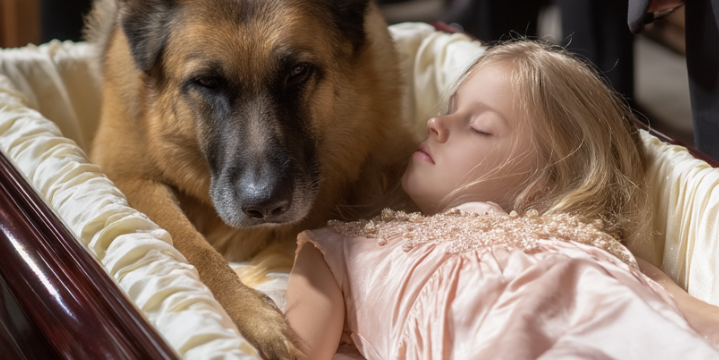I wish I could say this was just in my imagination—that it was exhaustion or stress making me see things that weren’t there. But it wasn’t. I wasn’t imagining any of it, and I would give anything to have been wrong.
My name is Martha. My husband, Jason, and I both work full-time, which means our four-year-old daughter, Beverly, spends most of her weekdays at daycare. It wasn’t the perfect setup, but Beverly was happy there, and we were managing as best as we could.

One morning, as I packed her lunchbox, I told Jason, “I just don’t want Bev to ever feel like we’re pushing her away.” He smiled, kissed my cheek, and said, “She’s doing great, love. You’re doing great.” I believed him—at least I wanted to.
A Kind Offer, or So It Seemed
A few weeks later, my mother-in-law, Cheryl, made what seemed like a generous offer. Over dinner one evening, she said, “How about I watch Beverly every Wednesday? It’ll give her a break from daycare and give me more time with my granddaughter.” She even suggested watching her at our house so Beverly would feel comfortable.
It sounded thoughtful. Cheryl and I had never been particularly close, but I appreciated the gesture. Besides, it would save us a little daycare money, and Beverly adored her grandmother. I agreed, grateful for the help.
For the first few weeks, everything appeared completely normal. Beverly came home happy, humming songs, showing off the drawings she’d made with Grandma. But soon, something began to change.
Beverly’s Strange Behavior
One evening at dinner, Beverly pushed away the plate I’d made and said cheerfully, “I only want to eat with Daddy, Grandma, and her friend today.” I froze for a second before asking gently, “Who’s Grandma’s friend, sweetheart?”
Beverly just smiled, sipped her juice, and said nothing more.
At first, I brushed it off as childish imagination—kids create imaginary friends all the time. But over the next few days, Beverly started mentioning “Grandma’s friend” more often.
One night as I tucked her into bed, she looked up at me and whispered, “Mommy, why don’t you like our friend?” I frowned. “Who told you that, honey?”
She replied in a tone far too serious for her age, “Our friend is part of the family. You just don’t see it yet.”
A chill crept through me. Something about her words didn’t sound like something a four-year-old would say.
Cheryl’s Smooth Explanation
That weekend, I decided to bring it up with Cheryl. I tried to sound casual as we sat in her kitchen. “Has Beverly been talking about a new friend? She keeps mentioning someone.”
Without looking up from her coffee, Cheryl smiled lightly and said, “Oh, you know how kids are. Probably just an imaginary friend.”
Her tone was too smooth, too practiced. My instincts told me she was hiding something.
That night, I couldn’t shake the feeling that something wasn’t right. My thoughts raced until I finally decided to do something I hadn’t done since Beverly was a newborn. I reinstalled a small security camera we’d once used when we had a night nanny. I positioned it discreetly in the living room—just to ease my mind.
What the Camera Showed
The following Wednesday, I left for work as usual. Around noon, I checked the footage on my phone. At first, everything seemed ordinary—Cheryl reading on the couch while Beverly played quietly with her toys.
Then, Cheryl glanced at her watch and said, “Bev, sweetheart, are you ready? Our friend will be here any minute.”
“Yes, Grandma!” Beverly chirped. “Do you think she’ll play with my hair again?”
My breath caught. Her?
Then Cheryl added softly, “You remember what we talked about, right? What we don’t tell Mommy?”
“Yes,” Beverly said sweetly. “Not a word to Mom.”
My heart pounded. The doorbell rang. Cheryl rose from the couch and walked to the door.
And then—I saw her.
A tall woman in a long black coat stepped inside. Her dark hair was pulled back tightly, her face pale and composed. She smiled warmly at Cheryl and bent down as Beverly ran into her arms like they’d known each other forever.
Cheryl greeted her as if expecting her. “Right on time. We’ve been waiting for you.”
The woman knelt beside Beverly, brushing her hair gently with her fingers. “Such a beautiful little girl,” she said softly.
My hands trembled as I watched. Who was this woman? Why was she in our home?
The woman whispered something into Beverly’s ear, and my daughter giggled. Then she said, “I promise, I won’t tell Mommy.”
At that exact moment, the woman turned her head toward the camera—directly toward it—and smiled. It wasn’t menacing, but something about it made my stomach twist.
The Confrontation
I shut the video and called Jason immediately. We both left work early, racing home. When we arrived, Cheryl was sitting calmly at the table, reading a magazine. Beverly played nearby, humming softly. There was no sign of the woman.
When I asked about her, Cheryl’s expression barely changed. “You’re overreacting,” she said smoothly. “She’s just an old family friend.”
I demanded a name, a phone number—anything. Cheryl refused. “You wouldn’t understand,” she said finally, turning away. That’s when I knew this wasn’t just my imagination.
We haven’t let Cheryl babysit since. I removed every camera, changed the locks, and made sure daycare resumed five days a week. Yet, even with those precautions, something lingers.
The Lingering Unease
Every so often, late at night, Beverly talks in her sleep. She doesn’t cry or thrash—she just murmurs softly. Sometimes, in the quiet of the house, I hear her say, “I miss our friend.”
Jason insists it’s just a passing phase. He thinks I’m letting fear take over. But every time I remember that woman’s calm gaze meeting the camera lens, I feel a shiver run down my spine.
I wish I could believe Cheryl’s explanation. I wish I could convince myself it was just an overactive imagination—a coincidence caught on camera. But deep down, I know what I saw.
And what unsettles me most isn’t that a stranger entered our home, but the quiet familiarity between her and my child… as if Beverly truly believed that woman belonged with us.
I’ve learned that sometimes the most frightening truths aren’t found in dark corners or eerie sounds—they’re found in the faces of those we think we know best.
Disclaimer: This story is a fictional work created solely for entertainment purposes. Any resemblance to actual persons, living or deceased, is entirely coincidental. All images included are for illustrative purposes only.





